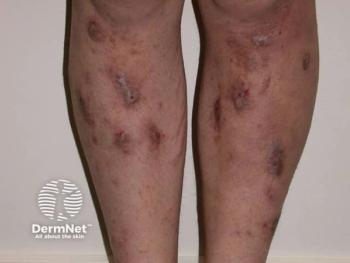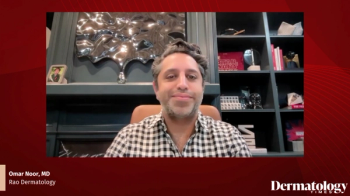
Fillers increasingly used in nontraditional areas for soft tissue augmentation
Filler procedures have become a staple in the dermatologic armamentarium for the treatment of numerous cosmetic indications, allowing physicians to perform sophisticated soft tissue augmentation procedures in their patients, safely and effectively. Though the correction of nasolabial folds was the first and perhaps the most popular indication for fillers, nontraditional areas where these cosmetic tools can be implemented are ever growing.
Miami Beach, Fla. - Filler procedures have become a staple in the dermatologic armamentarium for the treatment of numerous cosmetic indications, allowing physicians to perform sophisticated soft tissue augmentation procedures in their patients, safely and effectively. Though the correction of nasolabial folds was the first and perhaps the most popular indication for fillers, nontraditional areas where these cosmetic tools can be implemented are ever growing.
“Most of the currently available dermal fillers have been FDA (Food and Drug Administration) approved for the correction of the nasolabial folds, because the nasolabial folds were one of the pioneering areas in cosmetic filler treatments and there is a very good rating scale gauging treatment success,” says Rhoda S. Narins, M.D., clinical professor of dermatology, New York University School of Medicine, and director of the Dermatology Surgery and Laser Center, New York. “Though most of the fillers were initially approved for this indication, physicians are increasingly performing off-label aesthetic treatments, addressing a growing number of cosmetic indications.”
A number of nontraditional areas for soft tissue augmentation are being explored, include the earlobes, eyebrows, temples, tear trough, nose, lips, fine perioral lines, cheekbone area, chin, pre-jowl sulcus, jawline, hands, décolletage and nipples. Many dermal filler products and other filler techniques such as autologous fat grafting can be useful for correcting deformities and unevenness in body contour after suboptimal liposuction procedures, as well as for postsurgical repair, Dr. Narins says.
“I think the lips are now considered for many of the fillers as an area commonly treated, and some products have even recently received FDA approval for lip enhancement, bringing this indication into the mainstream of on-label filler treatments,” Dr. Narins says.
Picking the right filler
The type of filler a clinician chooses will depend largely on the individual patient, how much the patient is willing to invest, and the critical decision made by the physician regarding which filler is best for a given area, she says. Depending on the anatomical location and cosmetic correction to be made, Dr. Narins says some filler products can be better than others.
FDA-approved filler products and techniques include those made of hyaluronic acid (HA), calcium hydroxylapatite, poly-L-lactic acid, polymethyl methacrylate, silicone (off-label as a filler), as well as autologous fat. Synthetic dermal fillers are based on various technologies and properties, and each product can be differentiated in part by their degree of cross-linking, concentration, gel hardness (or G prime) and cohesivity. According to Dr. Narins, choosing the right filler for the right indication is instrumental in achieving excellent aesthetic outcomes.
“In my experience, fat grafting can give you a lot of volume but it is not a very ‘fine’ filler. I believe that in addition to different synthetic fillers, autologous fat is an excellent option for volumizing the cheek area, correcting lipoatrophy or replenishing the lost volume under the eyes, but it is not the best choice for lip enhancement or fine line filling,” she says. “Furthermore, many patients do not have excess fat or do not want an additional surgical procedure to harvest the fat.”
Patient selection for any cosmetic procedure is extremely important, and here, the physician has to critically evaluate and decide which filler would work best in a given patient based, in part, on several factors - such as the patient’s skin and type of cosmetic issue, Dr. Narins says. Other factors that may play a role in choosing the appropriate filler include cost, the longevity of filler outcomes as well as a filler product that a patient feels comfortable with.
HA popularity
Hyaluronic filler products are very popular in aesthetic medicine not only because of the excellent treatment outcomes one can achieve, according to Dr. Narins, but also because these fillers can be very forgiving in that the results can be reversed with hyaluronidase after the procedure.
“In order to help avoid suboptimal treatment outcomes, I believe it is often best not to overcorrect the target area. Filler procedures can be performed in multiple sessions over time so that you never get an overdone look. Depending on the indication, I also often prefer to use cannulas as this may help reduce the risk of complications such as bruising,” Dr. Narins says.
Physicians who perform soft tissue augmentation procedures should not only have an intimate knowledge of the local anatomy, but also should be well-versed in all of the available products and injection techniques, she says.
“Innovative dermal fillers have revolutionized the way physicians approach cosmetic augmentation procedures. As the off-label indications for these fillers continue to grow, physicians need to have a meticulous knowledge of each filler product and their fine nuances to be able to better decide which one works best for a given indication, ensuring maximum safety and aesthetic outcomes in their patients,” Dr. Narins says.
Disclosures: Dr. Narins reports no relevant financial interests.
Newsletter
Like what you’re reading? Subscribe to Dermatology Times for weekly updates on therapies, innovations, and real-world practice tips.


















